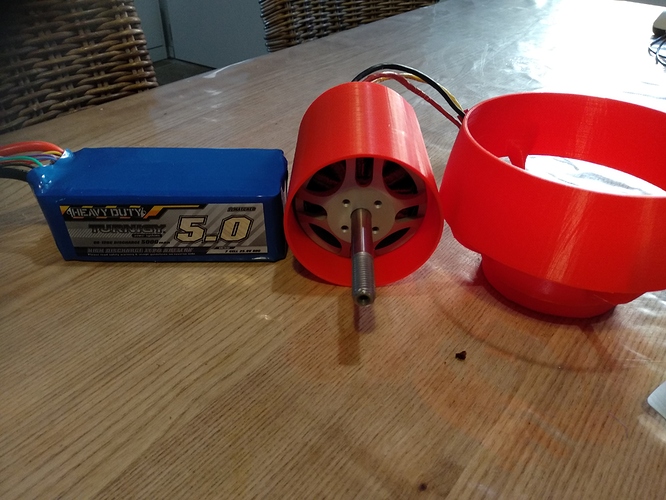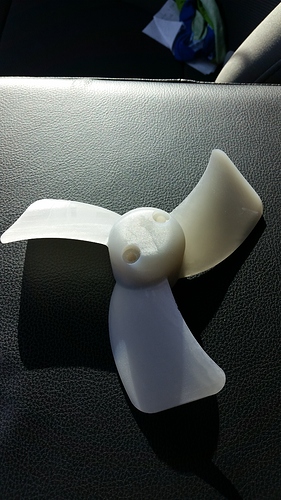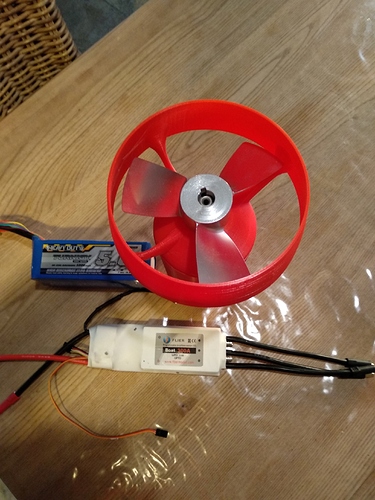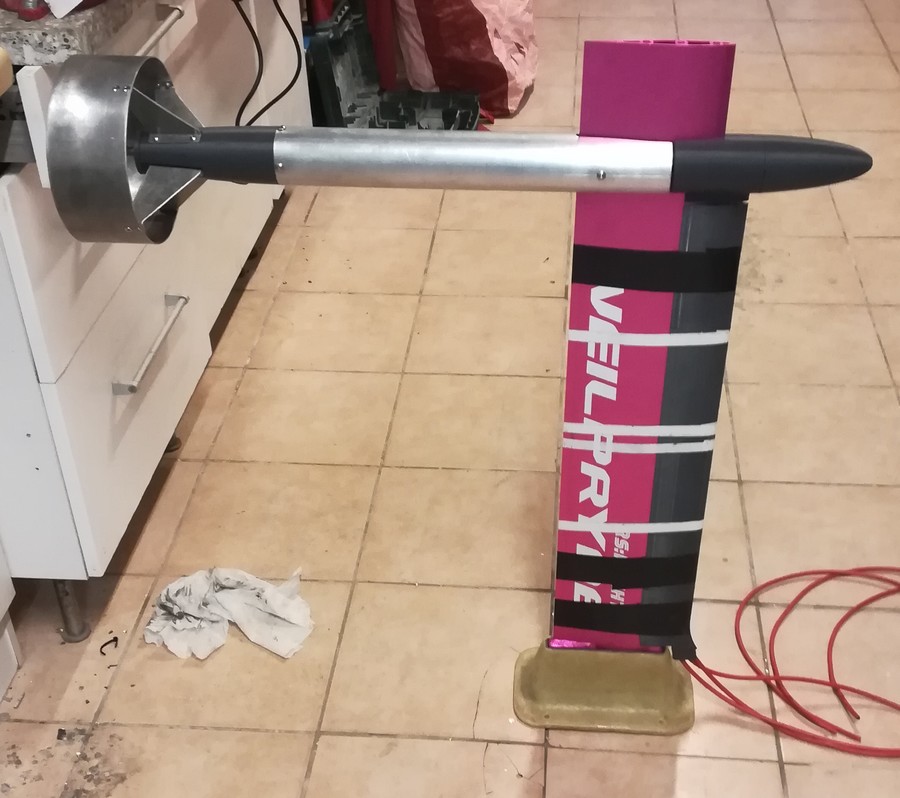Hey Mat, are you still using your carbon prop? I’m throwing blades around every 5 hrs of ride time, so much so that I have two spares at anyone time! I need to find a better solution. I was thinking I might layer one in carbon, does it effect the performance? Speed, battery life etc?
2 in series gives u 14S 5Ah, 2 more same series in parallel gives u 14S 10Ah. 
170kv at 14s is almost 10.000 rpm at prop.
Another question Mat or anyone that can answer. Why the need to waterproof the phase wires at the motor? After 6cm there is a non waterproof connector. So the phase wires are in the water anyway. Would we loose energy by having the wires inside the water ?
When i build my jetboard I was tired of unscrewing the waterproof lid of the board to charge the batteries. So I just had a + and - sticking out of the board for charging. I did measure if there will flow any Milli amps of current with small distance of the poles inside the water. I could not measure any current at 58volt I think.
I had a buddy sla print one. It is super strong and uses resin instead. I am trying to see if he can make some for a decent price.
well, the carbon one broke when my mast fell on the ground when i was fixing the board 
it was actually more efficient than the second version with the smooth transition from the motor OD, but i’m not sure of the reason yet (stiffness, smoothness of the profile, thickness of the profile…)
I actually waterproofed the connectors between the motor wires and the mast wires with sealing electrical tape.
If the wires were far apart with no chance of touching and only used in fresh water, you might be able to get away with it, but i’m using it in salty water, and the wires are bundled together, so I preferred to not take a chance…
As @Louis pointed out, 10 000 rpm will be a lot for a direct drive with a propeller, you’re getting in the jet range at that speed.
Having the motor in contact with the water will help a lot for the cooling, but makes it much harder to make a jet or use a duct around the propeller.
If you go for a out runner, the simpler is to leave it in the open… you’ve got most of the components anyway, so go for it and you can always change later 
Yes Thanks for feedback.
I have made my choice. I will finish my proto based on this OutRunnner as I have all stuff to do it.
Then I will see for second project with reductor and smaller motor.
What I have clearly understood since the beginning , is that in fact such project is really time consuming. So Keep Idea simple, one project at a time and try to do it as good as you can.
Next step to me : Isolate my engine to perform some water tests ; it means get all product to do it (Resin etc…) and also some “analyze tool” as you did mention in all posts…
Second Step, is to prepare the board and get an other “Foil Matt” ; I’m a bit scared to make a Hole in my Original Carbon Ketos Matt ; so I’m looking for a cheap approach for second product.
Keep IN touch.
Last picture to be loaded !
Do you plan any water inlets and outlets? Do you plan to print a kind of cap for the motor hub to have less pumping effekt from the arms to reduce friction?
Do you plan any water inlets and outlets? Do you plan to print a kind of cap for the motor hub to have less pumping effekt from the arms to reduce friction?
==> Yellow Picture was original idea to cool down the outrunner. Create external cavity around the “encapsulated” strcture to have internal inlets all around my Alien Motor. By doing so is increase surface and this surface with water going inside was supposed to be colder than without this approach.
As I said ; you can image plenty stuff in 3D printing but making things happen with metal such aluminium becomes an other story. I m sure this is a good idea but not easy to reach with my skills and tools.
For you second point ; not sure I got it…sorry 
Benj
Hi Mat,
I have several questions to make my own motor water protected. I hope my English won’t be too bad.
About the Resin ; Can I substitute it by something similar ? Quite boring to find it in France.
Equivalent might be epoxy for Aquarium or for Art Design.
RESINE
In the video ; you are using a kind of Green Tape to protect some part of the motor. I remembered something during my study but couldn’t find it anymore
New Shaft ; Why replacing the shaft by this titanium ? Does the original one won’t be ok ? Rust issue ?
Can I keep orignal one at least for first run or it is really mandatory to be replaced ?
Also why cutting the shaft so short / Shaft may help to avoid rotational issue with the prop ? By removing it your prop must be perfectly “centered” which can be quite difficult.
Connector : Electrical connector to easily Plug / Unplug it Water proof. I would like to avoid to “insert” connection inside the foil mast and putting some Glue or stuff to make it waterproof.
Any idea ?
Bearings : Have you replace original bearings ? Is it mandatory because it is damaged during disassembling ? More robust bearing for salty water ? Did you add some “greased” ?
??
Tks
Benj
I think any epoxy should work, as long at it’s sticky enough… may be try to find a surfboard epoxy as it will cure faster than the one you linked.
The green tape is a regular painters tape, it’s usually blue or creme color. It’s used to do masking when you paint something… it’s just to keep the resin from going on places where you don’t want it .
I replaced the shaft because the original one was way to long, and difficult to cut, I found cheap titanium ones of the right length, and I was 100% sure that titanium will not rust.
You can definitely keep the original one, if it’s stainless steel it should be fine for a while…
For the length I used exactly the piece i got. But you’re right that a little bit longer can help to center the prop. I just wanted to make sure it didn’t extend past the back of the motor to avoid touching the wire and to keep the overall length short.
For the connectors, I’m not sure you can find some waterproof ones that can handle the power, but you can use regular bullet connectors and protect them with good electrical tape, it’s easy to remove when you need to disconnect it.
I have no connection inside my mast, just the wires going through.
For the bearing, I didn’t damage the old ones, but I replaced them with some 316 stainless completely open (no seals) to be sure they will resist enough against the rust and that they can be easily cleaned after going in salty water. I was afraid salt water would stay stuck inside
Also, I protect them with “corrosion X” spray.
I hope this help!
@Mat How can I log data on my Flier 400. Went out for a long session today and literally have no details besides GPS. How do you log?
Nevermind @Mat. I found your post here:
Are you saying with the 150 amp limit it could blow? You know any good alternatives with that Flier ESC? Or do I need to switch to another ESC?
Thks, cristal clear you clarified all my doubt or pendings
IMHO, Ketos is a quality kitefoil maker but makes the worst candidates to become a efoil.
1- Not sure whether Ketos manufacture hollow masts. You should enquire first.
2- If they do, their KFbox head is so compact/optimised/perfect that if you remove the necessary material to let the 3+1 cables in, you will fragilise it in addition to the higher strain for a efoil board… double penalty.
If I had a Ketos foil, I would try to find a brand new or second hand alu mast, for ex Gong 65cm cost 59€ on their site + 30€ plate.
First you have to check that your Ketos fuselage screw spacing is compatible with the screw spacing of this mast,
If you think about enlarging your Ketos fuselage screw spacing, not sure it will resist as Ketos use a EPS foam core wrapped with carbon.
So the only solution left would be buying a alu foil.
I don’t know if it will blow up, i hope not, but the lead wires a significantly smaller than the 8AWG i’m using everywhere else. and looking at the deformations on the 3d printed support I have it mounted on, it’s heating up a bit during the sessions. But so far so good.
I tried other monitoring solutions (HTRC 200A not readable and no memory, and a 350A TK15 that blew up … probably because of the the few drop of water that i put on when opening the hatch while in the water  ) , but no other recording…
) , but no other recording…
+1, alu mast won’t be very expensive compare to the rest of the build (and the motor attachment made for liquid force was already modified for Slingshot), so keep your good foil for kite 
Arf fuc…
I was thinking naively not to mak a hole but to cut with dremel on one side of the mast to insert Cable + water tube then stratify with resin and carbon. At kfbox level I was targeting to pullout Cable & so just before the kfbox as in fact it is not really useful to go straight except for esthetic and some friction
That, is my first plan, I have différents front foils winds, so going on gong or something else is annoying
Second, plan looking and reading other dyi project was to add at least for proto an extra shield at mast as picture, it simplifies a lot don’t U think so! Saving my mast…



